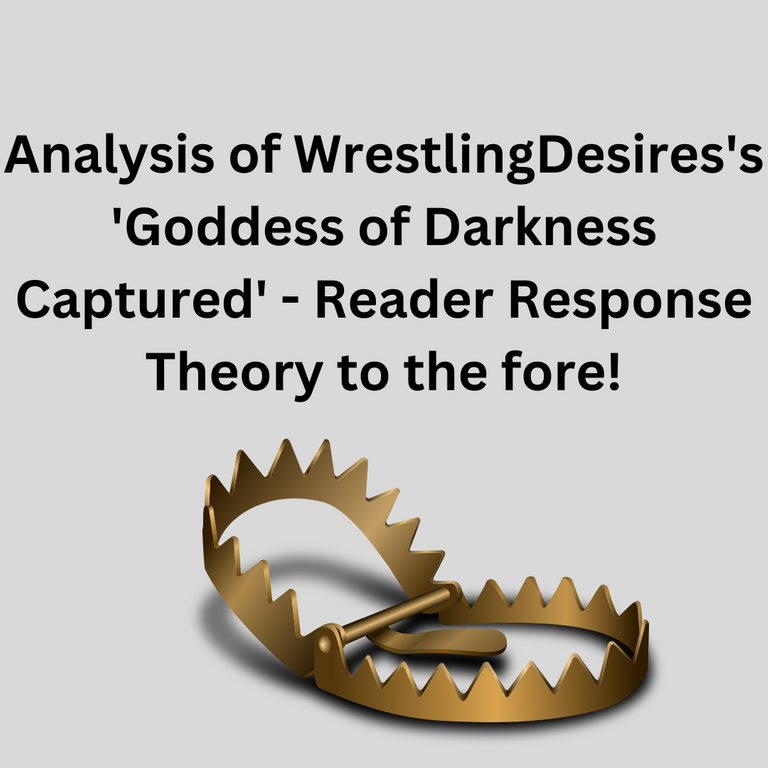
For the Hive Book Club challenge x Scholar and Scribe challenge, us readers over here on the Book Club side of things have been given the undertaking not to write, but to review! For this challenge I’ve come across my mate @wrestlingdesires piece, which has become the subject of an analysis below. I’m sure that WD will come back and tell us that we’re overthinking everything or that perhaps we’ve stretched something a bit too far – but, perhaps it’s a lesson: be careful how we construct a piece, as the responder may lose control of the interpretation! (Technically, this is called Reader Response Theory - basically it means that the reader construct's a text's meaning. WD - That's me!)
WD's piece can be found here: https://peakd.com/hive-199275/@wrestlingdesires/goddess-of-darkness-captured - it'stitled, 'Goddess of Darkness Captured' and it is part of a multi-part write up, and (I'm writing this intro last) I noticed I didn't focus on the titular goddess at all! Instead, I chose to focus my analytical response to the universality of how we engage with power.
WD opens his creative piece using simple diction to paint a precise image, ‘Bruce groaned as he looked up into the barrel of a pistol’. The introduction of Bruce through the verb, ‘groaned’ initially characterises him as a defeated character with a sense of heaviness, communicated through the long ‘o’ vowel sound. The auditory imagery then develops into a confronting image where Bruce is ‘looking up’ positioning him without power. This image of powerlessness, is not, however, confined to the ‘groan[ing] Bruce, as the other men in the text are described as ‘pull[ing] out a mobile phone, and hold it high, then look at it and curse’. This motif of powerlessness developed by WD establishes a universal sense of humanity in his piece, recognising we are in constant states of struggle.
This universality is further established by WD, who, having established the character of Bruce, initially only develops the figure holding the pistol as ‘the man’ and through the use of the pronoun, ‘he’ which creates a sense of mystery around the figure’s identity and his motives for his actions remain hidden. As the piece develops, the narrator moves on from this neutral language to label this figure as ‘captor’. The connotations of this label imply a strong sense of entrapment and moves him to being perceived by the audience as sinister, contrasting his apologetic language, ‘Sorry ma’am’ which he offers in response to Lilac’s exclamatory demands to set Bruce free.
This understanding of the ‘captor’ is again reinforced by the dependent clause, ‘asked the man who had captured them’. Here, the predicate seeks to reinforce this conceptual idea of entrapment, thus heightening the tension in the piece. Yet, the two dimensionality of this character is seemingly transformed through the direct speech of his partner, who complains, ‘You know I’ve never been on a horse, Marv’. By using the hypocorism ‘Marv’, the ‘captor’ has gained a sense of humanity, and the soft consonants in his name imply that the sinister language of the narrator may have prejudiced the audience’s understanding of him. Yet, this doubt is immediately questioned as Marv is given direct speech, ‘Tie these two up’. His use of the imperative voice again seeks to position the character in a position of power, reinforcing his relationship to Bruce which was established in the piece’s hook. This understanding is not maintained, however, as Marv adopts submissive language in his continued speech, ‘Yes boss, right away’. The character repeats the affirmation, ‘Yes boss’ twice in succession, undermining the character’s power and re-positioning Marv as powerless in that relationship.
The final character introduced in the piece is Marv’s accomplice Grady, who again WD develops by introducing him through the lens of the power imbalance motif. This is established again through Marv’s direct speech, who uses the colloquial ‘numbskull’ in order to position himself above Grady, undermining the latter’s sense of worth. The piece then concludes with Grady, ‘complaining about his situation…’. This ambiguous ending offers insight into Grady’s feelings of being troubled, whilst structurally concluding the piece to mirror Bruce’s opening ‘groan’. The punctuation used here is an ellipsis, the use of which communicates a sense of unease and hesitation which is being experienced by the character. By ending in a way which is not concrete, but implies something further, the audience are forced to confront their own power relationships in order to reconcile what might occur next.
By reading WD’s short story, of just under 400 words, three power imbalances were created.
- Bruce being powerless to Marv
- Marv being powerless to his boss
- Grady being powerless to Marv, despite being in a position of power over Bruce and Lilac.
We might naturally ask then, what insight into humanity has WD constructed? And it seems he wants to suggest the universality of this experience of power, the complexity of which is tied to the web of relationships we all exist in.








